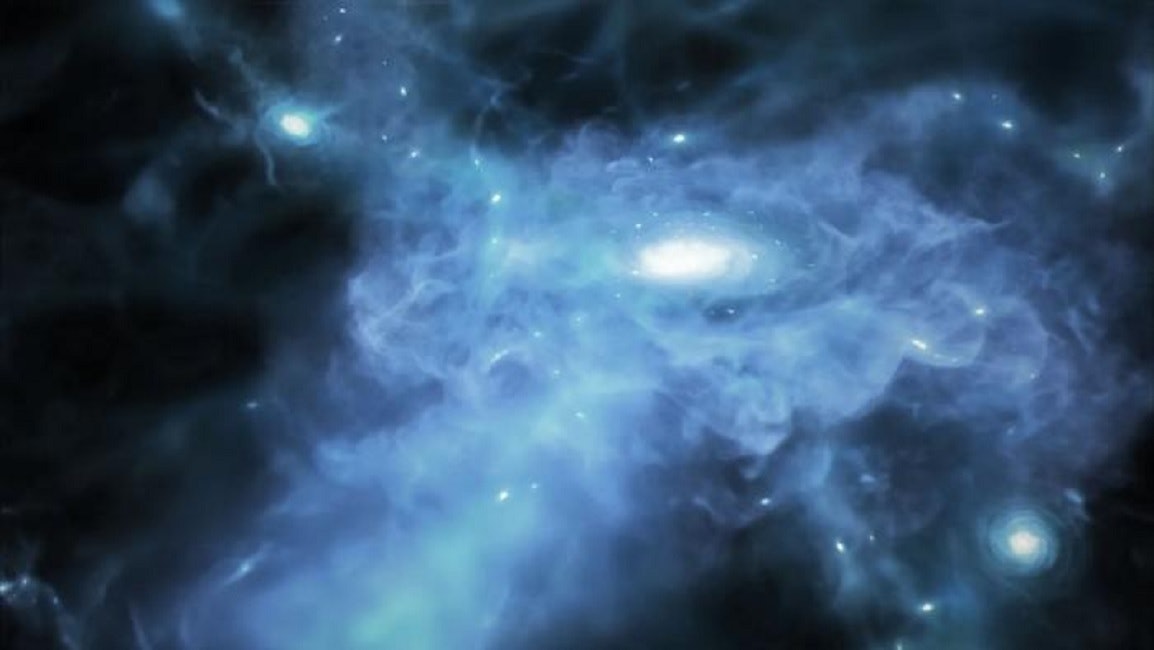
JWST recently caught three of the universe’s earliest galaxies in the act of pulling themselves together from a giant, dark cloud of hydrogen gas.
The three dim spots of red light in a recent batch of JWST data traveled more than 13 billion light years across space to reach the telescope’s mirrors. That ancient light carries a snapshot of what galaxies looked like between 400 and 600 million years after the Big Bang, back when the universe was basically a cosmic toddler. And all three of these early galaxies are shrouded in dense hydrogen gas, which is slowly falling into the galaxies’ gravity wells — where it will eventually help them form new stars.
University of Copenhagen astrophysicist Kasper Heintz and his colleagues published their work in the journal Science.

The Epoch of Reionization is Gonna be Lit
JWST’s instruments helpfully split the light from the distant galaxies into the individual wavelengths that make it up. The spectrum of light coming from an object, like a galaxy, is like a fingerprint of the chemicals that form it, because each chemical compound absorbs, emits, and reflects its own very specific wavelengths of light. Around the three distant galaxies, Heintz and his colleagues noticed that something seemed to be absorbing the same wavelengths of light as cold hydrogen gas – and lots of it.
“These galaxies are like sparkling islands in a sea of otherwise neutral, opaque gas,” says Heintz in a recent statement.
Hydrogen gas, when it’s cold and not electrically-charged (or ionized), absorbs light but doesn’t emit it. This neutral gas filled the early universe, making it impossible for light to travel very far, until a few hundred million years after the Big Bang: a period called the Cosmic Dark Ages.
It took powerful blasts of radiation from the first stars in the first galaxies to strip away electrons from all those hydrogen atoms, creating ionized gas (also called plasma) which is translucent instead of opaque. The Epoch of Reionization had begun – and the three galaxies in Heintz and his colleagues’ recent study are just starting to light it up.
Brand New Galaxies, Some Assembly Required
Somewhere between 13.2 billion and 13.4 billion years ago — when the light that just reached JWST started its long journey across space — these three early galaxies were still in the process of assembling themselves from the surrounding gas.
“[The data] suggests that we are seeing the assembly of neutral hydrogen into galaxies,” says University of Copenhagen astrophysicist Darach Watson, a coauthor of the recent study, in a statement. And that’s a stage of galaxy formation that astronomers haven’t seen before, especially in the very early universe.
The galaxies, in their infancy, are still surrounded by a cloud of cold, dark, neutral hydrogen gas — the same stuff that caused the Cosmic Dark Ages. Most of that gas will be heated up as it falls into the galaxies, pulled in by their inexorable gravity. And then it will slowly cool, forming lumps like congealed oatmeal, and some of those lumps will be so heavy that they collapse on themselves to form new stars.
Right now (or as we see them right now, which actually happened billions of years ago), what stars these early galaxies contain are mostly young and newly-formed.
“The fact that we are seeing large gas reservoirs also suggests that the galaxies have not had enough time to form most of their stars yet.” But they’ll get there, most likely.
The data reveals not only a previously unseen moment in a galaxy’s life, but also a glimpse of what the early universe was like before the expansion of space pulled everything farther apart, turning most galaxies into lonely beacons, or at most isolated clusters of lights, in the void.
“We’re moving away from a picture of galaxies as isolated ecosystems,” says University of Copenhagen astrophysicist Simone Nielsen in a recent statement. “At this stage in the history of the universe, galaxies are all intimately connected to the intergalactic medium with its filaments and structures of pristine gas.”
In the very early universe, no galaxy was an island (yet).




!["[T]he First and Fifth Amendments Require ICE to Provide Information About the Whereabouts of a Detained Person"](https://images.inkl.com/s3/publisher/cover/212/reason-cover.png?w=600)


